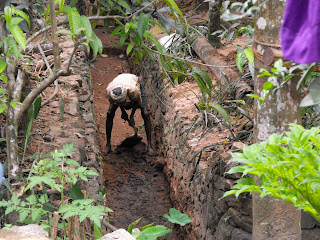In anticipation of our upcoming trip to Vandana Shiva’s Navdanya, Shiva’s own organic farm and research center for sustainable agriculture, we visited the Navdanya food stall in Delhi. The stall is located in a food and craft bazaar called Dilli Haat. The bazaar is a clam, clean and eclectic market. It has all the charm of the other markets we have visited, without the shady characters and pushy vendors.
We got to the market just as the sun was setting; all of us longing for a delicious dinner after a hot day of cultural immersion in Delhi. The food stall is nestled away in the back f the bazaar. We walked through the sea of hand made crafts and textiles, only focused on our growling stomachs. As we approached the stand Dr. Sharda Naik (our coordinator for the northern part of our trip, to whom we owe many thanks) greeted us. Sharda informed us that she had ordered us a very special meal. All of the food at the stall is locally grown and completely organic. The food fits with the Navdanya goal of reclaiming the traditional foods of India, using unique local fruits, grains and veggies to prepare a delicious vegetarian feast.
The meal started with two local juices. The first was a spicy mango with cumin and the other was called bheel sharbat, which is a sweet drink made from the local fruit bheel. These two drinks were unlike any I’ve had before; the mango juice was cool and refreshing with a slightly spicy, slightly salty after taste. The bheel sharbat’s gummy texture was thick as it ran down your throat and the drink left a familiar flavor in my mouth that I still can’t identify.
The food was served buffet style on large platters overflowing with an assortment of colorful indigenous foods. There were familiar foods like fried yellow dal and okra and ones that we had yet to encounter like the amaranth and potato cutlets (which get two thumbs up from the entire group). The highlight of the meal for me was the bottle gourd kofta, which consisted of balls of vegetables and paneer in a creamy spicy sauce yellow orange colored sauce. The food truly tasted fresh and each of us had seconds or thirds. Even the roti, which accompanied nearly every meal that we have eaten in India, had a new twist. It was made with nine indigenous grains straight from Navdanya, giving it a rich coco color as opposed to the usual white.
When the meal was over we walked away from the food stall with belts loosened and big smiles on our faces, eager for the chance to see where this delicious food was grown.
























